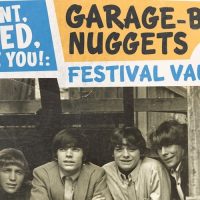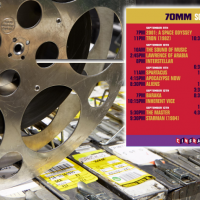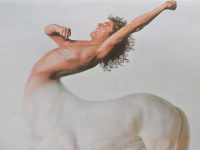It hasn’t received anywhere near the same notoriety as the much better known rock festival documentaries Woodstock and Gimmie Shelter, but Murray Lerner’s largely forgotten Message To Love: The Isle of Wight Festival deserves to be seen both by fans, and especially by students of late-1960s rock history.
This remarkable film, in many ways, serves as a perfect bookend to both of its more famous counterparts. Where Woodstock effectively showed both the incredible music (and all of the accompanying excesses) of the 1960s counterculture at the peak of its influence, and Gimmie Shelter revealed the sharp contrasts of its much darker underside, Isle Of Wight captures both of these two extremes (within the single frames of a very inspired piece of film-making) at the same time.
Lerner’s film is really like two movies in one.
On the one hand, there is the music.
A very decent argument could be made that the talent lineup for 1970’s Isle of Wight festival in England was actually far superior to the one assembled for 1969’s Woodstock gathering in upstate New York. It was certainly more varied and eclectic. In addition to superstar rock acts like Jimi Hendrix, The Doors, and the Who, Isle Of Wight had everything from the avant-jazz of Miles Davis, to country singer/songwriter Kris Kristofferson on the bill. Although some of the performances on the DVD version of this film are cut a little bit too short (most notably, those by Hendrix and the Doors), what is actually seen and heard here is often explosive.
This includes two positively electrifying songs (“Young Man Blues” and an extended “Naked Eye”) from The Who, that leave you breathless, stunned, and wanting to hear much more once they have ended all at the same time. Fortunately, the Who’s complete Isle Of Wight set was released as its own DVD — one that has long since been recognized by some fans as the definitive Who concert, and arguably one of the greatest in all of rock history.
There are also some great performances here from Jethro Tull, Miles Davis (with a great band including keyboard virtuosos Chick Corea and Keith Jarrett), and then up-and-comers Free (with a young Paul Rodgers) and Taste (with Irish guitar whiz Rory Gallagher).
From a historical perspective though, what is seen and heard here from Hendrix and the Doors is the most worthy of note. Hendrix’s set at the Isle of Wight — represented here by great versions of “Voodoo Child,” “Foxy Lady” and a frustratingly short snippet of “Machine Gun” — of course proved to be one of his last, as he would be found dead just 18 days later.
The Doors epic “When The Music’s Over” also seems to be the unfortunate victim of editing for space. But the footage that actually made the final cut is no less fascinating.
Decent film of the Doors performing live is hard enough to come by as it is. But footage of the bearded, post-Miami bust Jim Morrison is even rarer. What makes this particular piece of rock history most interesting though, isn’t so much its rarity, nor the fact that Morrison would also be dead just a year later. Morrison himself is a far cry from the leather clad, Lizard King sex symbol of his better years here. But for the few minutes of the mid-section of “When The Music’s Over” seen on this DVD, Jimbo strikes an eerily haunting pose. As it turns out, the song itself was a perfect choice for the Isle of Wight. Because as the rest of this DVD shows, things soon after began to spiral completely out of control at the festival.
It is in fact, that “other story” about the Isle Of Wight festival that makes Lerner’s film one of the more fascinating, if largely unseen, rock documentaries ever made. This is a viewing experience that is every bit as riveting to watch as something like Gimmie Shelter. In much the same way that the Stones movie documents the tragedy at Altamont, Lerner unintentionally captures the behind-the-scenes story of festival promoters desperately trying to hold things together, as a confrontation between angry hippies attempting to storm the gates and festival security (complete with guard dogs) escalates out of control.
Eventually the chaos outside the main arena bowl reaches the concert itself, when a crazed hippie (who bares an uncanny looking resemblance to Charles Manson) attempts to storm the stage during Joni Mitchell’s set. In the aftermath of this, a visibly shaken Mitchell angrily appeals to the crowd to show some respect, while the Manson guy is seen babbling some presumably acid-influenced nonsense about painting the fences invisible. In another scene, the festival emcee — a guy named “Rikki” — angrily rails at the audience from the stage, at one point even calling them “bastards” and “pigs.”
So much for the peace, love and music hyperbole of 1960s rock and roll.
Jim Morrison may not have known it, but he was right on the money when he sang “When The Music’s Over” at the Isle Of Wight festival.
[amazon_enhanced asin=”1573306932″ container=”” container_class=”” price=”All” background_color=”FFFFFF” link_color=”000000″ text_color=”0000FF” /] [amazon_enhanced asin=”B000002AGB” container=”” container_class=”” price=”All” background_color=”FFFFFF” link_color=”000000″ text_color=”0000FF” /] [amazon_enhanced asin=”1617130370″ container=”” container_class=”” price=”All” background_color=”FFFFFF” link_color=”000000″ text_color=”0000FF” /] [amazon_enhanced asin=”B0013AFIW6″ container=”” container_class=”” price=”All” background_color=”FFFFFF” link_color=”000000″ text_color=”0000FF” /] [amazon_enhanced asin=”B002RVEDE4″ container=”” container_class=”” price=”All” background_color=”FFFFFF” link_color=”000000″ text_color=”0000FF” /]
- Pink Floyd – The Story Of 'Wish You Were Here' (2012) - June 29, 2012
- 'Neil Young FAQ' Diaries: On the Beach, Now and Then and the Kershaw Connection - June 15, 2012
- The Rockologist: The Raconteurs – Live At Montreux (2012) - June 8, 2012




